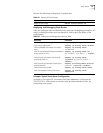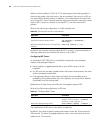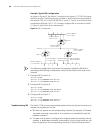
92 CHAPTER 5: IP ROUTING PROTOCOL OPERATION
default multicast address is 224.0.0.9. The advantage of transmitting packets in
the multicast mode is that the hosts in the same network that do not run RIP, do
not receive RIP broadcast packets. In addition, this mode prevents the hosts that
are running RIP-1 from incorrectly receiving and processing the routes with subnet
mask in RIP-2. When an interface is running RIP-2, it can also receive RIP-1
packets.
Perform the following configuration in VLAN interface view.
By default, the interface receives and sends RIP-1 packets. It transmits packets in
multicast mode when the interface RIP version is set to RIP-2.
Configuring RIP Timers
As stipulated in RFC1058, RIP is controlled by three timers: period update,
timeout, and garbage-collection:
■ Period update is triggered periodically to send all RIP routes to all the
neighbors.
■ If a RIP route has not been updated when the timeout timer expires, the route
will be considered unreachable.
■ If the garbage-collection timer times out before the unreachable route is
updated by the update packets from the neighbors, the route will be deleted
completely from the routing table.
Modification of these timers can affect the convergence speed of RIP.
Perform the following configuration in RIP view.
The modification of RIP timers takes effect immediately.
By default, the values of period update and timeout timers are 30 seconds and
180 seconds. The value of garbage-collection timer is four times that of period
update timer, 120 seconds.
Table 86 Specifying RIP Version of the Interface
Operation Command
Specify the interface version as RIP-1 rip version 1
Specify the interface version as RIP-2 rip version 2 [ broadcast |
multicast ]
Restore the default RIP version running on the
interface
undo rip version { 1 | 2 }
Table 87 Configuring RIP Timers
Operation Command
Configure RIP timers timers { update
update-timer-length | timeout
timeout-timer-length }*
Restore the default settings of RIP undo timers { update | timeout } *


















